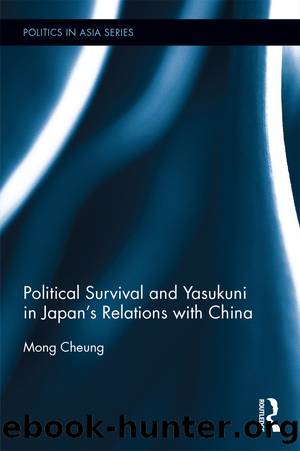Political Survival and Yasukuni in Japan's Relations With China by Mong Cheung

Author:Mong Cheung [Cheung, Mong]
Language: eng
Format: epub
Tags: International Relations, Diplomacy, Japan, Social Science, Political Science, Asia, History, Regional Studies
ISBN: 9781317369486
Google: 2yRqDAAAQBAJ
Goodreads: 30660866
Publisher: Routledge
Published: 2016-06-17T00:00:00+00:00
Koizumiâs Yasukuni visit in 2006
After the fifth Yasukuni visit, a Sino-Japanese top-level dialogue became almost impossible during the APEC summit held in Pusan, South Korea on November 18â19, 2005. According to Sugimoto Nobuyuki, the former consul-general in Shanghai, China started to refuse to hold summits with Koizumi even on an international occasion.112 In addition, Beijing criticized Koizumi continually. Chinese foreign minister Li Zhaoxing pointed out that visiting the Yasukuni Shrine is the equivalent of mourning Hitler and that he hoped the Japanese government would not hurt the feelings of the Chinese people.113 Abe Shinzo, the new chief cabinet secretary, refuted China by addressing it as natural for a national leader to pay respect to those soldiers who died for their country.114 As there was no sign of any possible Japanese concession, China declared a suspension of the leadership summit during the ASEAN Plus Three conference held in Malaysia on December 4, 2005.115 Koizumi, however, did not show any sign of concession. During the summit, Koizumi again stressed that he supported the ChinaâJapan friendship and had no intentions of glorifying the war. He stated that he could not understand what was wrong with his visit, which aimed at praying for the dead and for peace, since all actions are a matter of freedom of thought.116 On January 4, 2006, Koizumi again criticized Beijing, saying that it was hard to understand why China and South Korea were interested in interfering with the Yasukuni issue, a Japanese internal affair and a matter of the heart.117 On January 25, Koizumi criticized China and South Korea by stressing that only these two countries kept talking about the Yasukuni issue.118 On February 4, Koizumi mentioned that it had been highly unusual for China and South Korea to link the Yasukuni visits with the top-leader summit.119 In the following months, Koizumi repeatedly stressed the point at a frequency of almost once a month.
As Koizumi demonstrated no signs of changing stance over the Yasukuni issue for almost five years, Beijing started to reconsider its strategy toward Japan in late 2005. Chinese ambassador to Japan Wang Yi was called back to Beijing for about a month and a half. It was reported that a high-level meeting on Sino-Japanese relations was held in Beijing in late December 2005, with the assistance of Japan specialists in major think tanks. Three points on Chinaâs new Japan policy were confirmed during the meeting: (1) Chinaâs diplomacy to Japan should be maintained as a top priority; (2) there would be no compromise over the Yasukuni issue; and (3) China should improve its relations with Japan in any areas possible.120 Beijing had already been at odds with Koizumi in 2006 and started to build connections with other important figures in the LDP. During a meeting with Noda Takeshi, the chairman of the ChinaâJapan Friendship Association, State Councillor Tang Jiaxuan stated that he would not place hope in Koizumi over the Yasukuni issue anymore and Sino-Japanese relations would not improve during the Koizumi administration.121 Chinese president
Download
This site does not store any files on its server. We only index and link to content provided by other sites. Please contact the content providers to delete copyright contents if any and email us, we'll remove relevant links or contents immediately.
Spell It Out by David Crystal(35861)
Life for Me Ain't Been No Crystal Stair by Susan Sheehan(35546)
Cecilia; Or, Memoirs of an Heiress — Volume 1 by Fanny Burney(32085)
Cecilia; Or, Memoirs of an Heiress — Volume 3 by Fanny Burney(31476)
Cecilia; Or, Memoirs of an Heiress — Volume 2 by Fanny Burney(31431)
The Great Music City by Andrea Baker(30928)
Professional Troublemaker by Luvvie Ajayi Jones(29436)
We're Going to Need More Wine by Gabrielle Union(18654)
Twilight of the Idols With the Antichrist and Ecce Homo by Friedrich Nietzsche(18314)
The Secret History by Donna Tartt(18250)
All the Missing Girls by Megan Miranda(14828)
Cat's cradle by Kurt Vonnegut(14799)
Pimp by Iceberg Slim(13818)
Bombshells: Glamour Girls of a Lifetime by Sullivan Steve(13711)
Fifty Shades Freed by E L James(12933)
Talking to Strangers by Malcolm Gladwell(12909)
Norse Mythology by Gaiman Neil(12875)
The Social Justice Warrior Handbook by Lisa De Pasquale(11965)
Underground: A Human History of the Worlds Beneath Our Feet by Will Hunt(11855)
